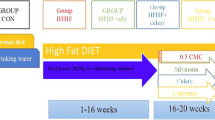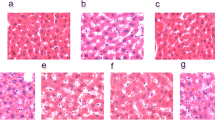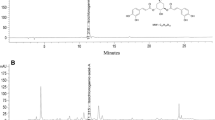Abstract
Nonalcoholic fatty liver disease (NAFLD) is regarded as the hepatic manifestation of the metabolic syndrome. It begins with the accumulation of fat in the liver (simple steatosis), which if untreated can progress to nonalcoholic steatohepatitis, cirrhosis, and hepatocellular carcinoma. Chrysin is a flavonoid present in bee propolis and many other plants. The objective of this study was to determine if chrysin can ameliorate NAFLD induced by feeding a high fructose diet (HFD) in rats. The rats were divided into five groups: normal control, HFD control, chrysin (25, 50, and 100 mg/kg p.o. body weight). Biochemical estimations were carried out in the serum and liver of rats. The gene expressions of SREBP-1c and PPAR α were determined in the liver. The histopathology of the liver was also studied. Chrysin caused a significant decrease in the serum fasting glucose and improved the insulin resistance, dyslipidemia, and liver enzymes. It caused a significant decrease in the liver weight and hepatic free fatty acids, triglyceride, and cholesterol content. Chrysin exerted antioxidant effects, reduced carbonyl content, advanced glycation end products, collagen, TNF-α, and IL-6 concentrations in the liver. Chrysin significantly reduced the hepatic gene expression of SREBP-1c and increased that of PPAR-α. The histopathology of liver of rats treated with chrysin showed significant decrease in the steatosis, ballooning, and lobular inflammation when compared to the HFD control group. Thus, chrysin demonstrated anti-steatotic, antiglycating, antioxidant, anti-inflammatory, and antifibrotic effects and seems to be a promising molecule for the management of NAFLD.



Similar content being viewed by others
Abbreviations
- AGE:
-
advanced glycation end products
- ALP:
-
alkaline phosphatase
- ALT:
-
alanine aminotransferase
- AST:
-
aspartate aminotransferase
- AU:
-
arbitrary units
- C25:
-
chrysin 25 mg/kg body weight
- C50:
-
chrysin 50 mg/kg body weight
- C100:
-
chrysin100 mg/kg body weight
- ELISA:
-
enzyme-linked immunosorbent assay
- FFA:
-
free fatty acids
- GSH:
-
reduced glutathione
- GGT:
-
gamma glutamyl transferase
- HDL-C:
-
high density lipoprotein cholesterol
- HFD:
-
high fructose diet
- HOMA-IR:
-
homeostasis model assessment-insulin resistance
- LDL-C:
-
low density lipoprotein cholesterol
- MDA:
-
malondialdehyde
- NAFLD:
-
nonalcoholic fatty liver disease
- NASH:
-
nonalcoholic steatohepatitis
- NC:
-
normal control
- PPAR-α:
-
peroxisome proliferator activated receptor alpha
- SOD:
-
superoxide dismutase
- SREBP-1c:
-
sterol regulatory element binding protein-1c
- TC:
-
total cholesterol
- TG:
-
triglycerides
- VLDL-C:
-
very low density lipoprotein cholesterol
References
Aebi H (1984) Catalase in vitro. Methods Enzymol 105:121–126
Ali N, Rashid S, Nafees S, Hasan SK, Sultana S (2014) Beneficial effects of chrysin against methotrexate-induced hepatotoxicity via attenuation of oxidative stress and apoptosis. Mol Cell Biochem 385(1–2):215–223. https://doi.org/10.1007/s11010-013-1830-4
Anand KV, Anandhi R, Pakkiyaraj M, Geraldine P (2011) Protective effect of chrysin on carbon tetrachloride (CCl4)-induced tissue injury in male Wistar rats. Toxicol Ind Health 27(10):923–933. https://doi.org/10.1177/0748233711399324
Anand KV, Mohamed Jaabir MS, Thomas PA, Geraldine P (2012) Protective role of chrysin against oxidative stress in d-galactose-induced aging in an experimental rat model. Geriatr Gerontol Int 12(4):741–750. https://doi.org/10.1111/j.1447-0594.2012.00843.x
Awad AS, Abd Al Haleem EN, El-Bakly WM, Sherief MA (2016) Thymoquinone alleviates nonalcoholic fatty liver disease in rats via suppression of oxidative stress, inflammation, apoptosis. Naunyn Schmiedeberg's Arch Pharmacol 389(4):381–391. https://doi.org/10.1007/s00210-015-1207-1
Buzzetti E, Pinzani M, Tsochatzis EA (2016) The multiple-hit pathogenesis of non-alcoholic fatty liver disease (NAFLD). Metabolism 65(8):1038–1048. https://doi.org/10.1016/j.metabol.2015.12.012
Choi JH, Yun JW (2016) Chrysin induces brown fat-like phenotype and enhances lipid metabolism in 3T3-L1 adipocytes. Nutrition 32(9):1002–1010. https://doi.org/10.1016/j.nut.2016.02.007
Ciftci O, Vardi N, Ozdemir I (2013) Effects of quercetin and chrysin on 2, 3, 7, 8-tetrachlorodibenzo-p-dioxin induced hepatotoxicity in rats. Environ Toxicol 28(3):146–154. https://doi.org/10.1002/tox.20707
Del Ben M, Polimeni L, Baratta F, Pastori D, Angelico F (2017) The role of nutraceuticals for the treatment of non-alcoholic fatty liver disease. Br J Clin Pharmacol 83(1):88–95. https://doi.org/10.1111/bcp.12899
Diehl AM, Day C (2017) Cause, pathogenesis, and treatment of nonalcoholic steatohepatitis. N Engl J Med 377(21):2063–2072. https://doi.org/10.1056/NEJMra1503519
El-Bassossy HM, Abo-Warda SM, Fahmy A (2013) Chrysin and luteolin attenuate diabetes-induced impairment in endothelial-dependent relaxation: effect on lipid profile, AGEs and NO generation. Phytother Res 27(11):1678–1684. https://doi.org/10.1002/ptr.4917
Eldutar E, Kandemir FM, Kucukler S, Caglayan C (2017) Restorative effects of chrysin pretreatment on oxidant–antioxidant status, inflammatory cytokine production, and apoptotic and autophagic markers in acute paracetamol-induced hepatotoxicity in rats: an experimental and biochemical study. J Biochem Mol Toxicol 31(11):e21960. https://doi.org/10.1002/jbt.21960
Falholt K, Lund B, Falholt W (1973) An easy colorimetric micromethod for routine determination of free fatty acids in plasma. Clin Chim Acta 46(2):105–111
Feng X, Qin H, Shi Q, Zhang Y, Zhou F, Wu H, Ding S, Niu Z, Lu Y, Shen P (2014) Chrysin attenuates inflammation by regulating M1/M2 status via activating PPARγ. Biochem Pharmacol 89(4):503–514. https://doi.org/10.1016/j.bcp.2014.03.016
Friedewald WT, Levy RI, Fredrickson DS (1972) Estimation of the concentration of low-density lipoprotein cholesterol in plasma, without use of the preparative ultracentrifuge. Clin Chem 18(6):499–502
Ghouri N, Preiss D, Sattar N (2010) Liver enzymes, nonalcoholic fatty liver disease, and incident cardiovascular disease: a narrative review and clinical perspective of prospective data. Hepatology 52(3):1156–1161. https://doi.org/10.1002/hep.23789
Jagtap AG, Patil PB (2010) Antihyperglycemic activity and inhibition of advanced glycation end product formation by Cuminum cyminum in streptozotocin induced diabetic rats. Food Chem Toxicol 48(8–9):2030–2036. https://doi.org/10.1016/j.fct.2010.04.048
Jin L, Fu X, Yao S, Yang J, Ning G, Zhang Z (2019) Protective effects of protopanaxatriol on acute liver injury induced by concanavalin a. Naunyn Schmiedeberg's Arch Pharmacol 392(1):81–87. https://doi.org/10.1007/s00210-018-1567-4
Kanuri G, Bergheim I (2013) In vitro and in vivo models of non-alcoholic fatty liver disease (NAFLD). Int J Mol Sci 14(6):11963–11980. https://doi.org/10.3390/ijms140611963
Kersten S, Stienstra R (2017) The role and regulation of the peroxisome proliferator activated receptor alpha in human liver. Biochimie 136:75–84. https://doi.org/10.1016/j.biochi.2016.12.019
Khan MS, Devaraj H, Devaraj N (2011) Chrysin abrogates early hepatocarcinogenesis and induces apoptosis in N-nitrosodiethylamine-induced preneoplastic nodules in rats. Toxicol Appl Pharmacol 251(1):85–94. https://doi.org/10.1016/j.taap.2010.12.004
Kismet K, Ozcan C, Kuru S, Gencay Celemli O, Celepli P, Senes M, Guclu T, Sorkun K, Hucumenoglu S, Besler T (2017) Does propolis have any effect on non-alcoholic fatty liver disease? Biomed Pharmacother 90:863–871. https://doi.org/10.1016/j.biopha.2017.04.062
Lee EJ, Kang MK, Kim D, Kim YH, Oh H, Kang YH (2018) Chrysin inhibits advanced glycation end products-induced kidney fibrosis in renal mesangial cells and diabetic kidneys. Nutrients 10(7):882. https://doi.org/10.3390/nu10070882
Lee EJ, Kang MK, Kim YH et al (2019) Dietary chrysin suppresses formation of actin cytoskeleton and focal adhesion in AGE-exposed mesangial cells and diabetic kidney: role of autophagy. Nutrients 11(1):–E127. https://doi.org/10.3390/nu11010127
Lowry OH, Rosebrough NJ, Farr AL, Randall RJ (1951) Protein measurement with the Folin phenol reagent. J Biol Chem 193:265–275
Mani R, Natesan V (2018) Chrysin: sources, beneficial pharmacological activities, and molecular mechanism of action. Phytochemistry 145:187–196. https://doi.org/10.1016/j.phytochem.2017.09.016
Marklund S, Marklund G (1974) Involvement of the superoxide anion radical in the autoxidation of pyrogallol and a convenient assay for superoxide dismutase. Eur J Biochem 47(3):469–474
Matafome P, Nunes E, Louro T, Amaral C, Crisóstomo J, Rodrigues L, Moedas AR, Monteiro P, Cipriano A, Seiça R (2009) A role for atorvastatin and insulin combination in protecting from liver injury in a model of type 2 diabetes with hyperlipidemia. Naunyn Schmiedeberg's Arch Pharmacol 379(3):241–251. https://doi.org/10.1007/s00210-008-0363-y
Mazidi M, Katsiki N, Banach M (2018) A higher flavonoid intake is associated with less likelihood of nonalcoholic fatty liver disease: results from a multiethnic study. J Nutr Biochem 65:66–71. https://doi.org/10.1016/j.jnutbio.2018.10.001
Ohkawa H, Ohishi N, Yagi K (1979) Assay for lipid peroxides in animal tissues by thiobarbituric acid reaction. Anal Biochem 95(2):351–358
Pai SA, Munshi RP, Panchal FP et al (2019) Plumbagin reduces obesity and nonalcoholic fatty liver disease induced by fructose in rats through regulation of lipid metabolism, inflammation and oxidative stress. Biomed Pharmacother 111:686–694. https://doi.org/10.1016/j.biopha.2018.12
Pereira ENGD, Silvares RR, Flores EEI et al (2017) Hepatic microvascular dysfunction and increased advanced glycation end products are components of non-alcoholic fatty liver disease. PLoS One 12(6):e0179654. https://doi.org/10.1371/journal.pone.0179654
Pushpavalli G, Kalaiarasi P, Veeramani C, Pugalendi KV (2010) Effect of chrysin on hepatoprotective and antioxidant status in D-galactosamine-induced hepatitis in rats. Eur J Pharmacol 631(1–3):36–41. https://doi.org/10.1016/j.ejphar.2009.12.031
Rashid S, Ali N, Nafees S, Ahmad ST, Arjumand W, Hasan SK, Sultana S (2013) Alleviation of doxorubicin-induced nephrotoxicity and hepatotoxicity by chrysin in Wistar rats. Toxicol Mech Methods 23(5):337–345. https://doi.org/10.3109/15376516.2012.759306
Rehman MU, Ali N, Rashid S, Jain T, Nafees S, Tahir M, Khan AQ, Lateef A, Khan R, Hamiza OO, Kazim S, Qamar W, Sultana S (2014) Alleviation of hepatic injury by chrysin in cisplatin administered rats: probable role of oxidative and inflammatory markers. Pharmacol Rep 66(6):1050–1059. https://doi.org/10.1016/j.pharep.2014.06.004
Renuka M, Vijayakumar N, Ramakrishnan A (2016) Chrysin, a flavonoid attenuates histological changes of hyperammonemic rats: a dose dependent study. Biomed Pharmacother 82:345–354. https://doi.org/10.1016/j.biopha.2016.05.013
Reznick AZ, Packer L (1994) Oxidative damage to proteins: spectrophotometric method for carbonyl. Methods Enzymol 233:357–363
Rotman Y, Sanyal AJ (2017) Current and upcoming pharmacotherapy for non-alcoholic fatty liver disease. Gut 66(1):180–190. https://doi.org/10.1136/gutjnl-2016-312431
Samarghandian S, Azimi-Nezhad M, Samini F, Farkhondeh T (2016) Chrysin treatment improves diabetes and its complications in liver, brain, and pancreas in streptozotocin-induced diabetic rats. Can J Physiol Pharmacol 94(4):388–393. https://doi.org/10.1139/cjpp-2014-0412
Satyanarayana K, Sravanthi K, Shaker IA, Ponnulakshmi R, Selvaraj J (2015) Role of chrysin on expression of insulin signaling molecules. J Ayurveda Integr Med 6(4):248–258. https://doi.org/10.4103/0975-9476.157951
Sedlak J, Lindsay RH (1968) Estimation of total, protein-bound, and nonprotein sulfhydryl groups in tissue with Ellman’s reagent. Anal Biochem 25(1):192–205
Soyal SM, Nofziger C, Dossena S, Paulmichl M, Patsch W (2015) Targeting SREBPs for treatment of the metabolic syndrome. Trends Pharmacol Sci 36(6):406–416. https://doi.org/10.1016/j.tips.2015.04.010
Sumida Y, Yoneda M (2018) Current and future pharmacological therapies for NAFLD/NASH. J Gastroenterol 53(3):362–376. https://doi.org/10.1007/s00535-017-1415-1
Tahir M, Sultana S (2011) Chrysin modulates ethanol metabolism in Wistar rats: a promising role against organ toxicities. Alcohol Alcohol 46(4):383–392. https://doi.org/10.1093/alcalc/agr038
Tappy L (2018) Fructose-containing caloric sweeteners as a cause of obesity and metabolic disorders. J Exp Biol 221(Suppl 1):jeb164202. https://doi.org/10.1242/jeb.164202
Tariq Z, Green CJ, Hodson L (2014) Are oxidative stress mechanisms the common denominator in the progression from hepatic steatosis towards non-alcoholic steatohepatitis (NASH)? Liver Int 34(7):e180–e190. https://doi.org/10.1111/liv.12523
Taslimi P, Kandemir FM, Demir Y, İleritürk M, Temel Y, Caglayan C, Gulçin İ (2019) The antidiabetic and anticholinergic effects of chrysin on cyclophosphamide-induced multiple organ toxicity in rats: pharmacological evaluation of some metabolic enzyme activities. J Biochem Mol Toxicol doi. https://doi.org/10.1002/jbt.22313
Veeramani C, Alsaif MA, Al-Numair KS (2017) Lavatera critica, a green leafy vegetable, controls high fat diet induced hepatic lipid accumulation and oxidative stress through the regulation of lipogenesis and lipolysis genes. Biomed Pharmacother 96:1349–1357. https://doi.org/10.1016/j.biopha.2017.11.072
Wallace TM, Levy JC, Matthews DR (2004) Use and abuse of HOMA modeling. Diabetes Care 27(6):1487–1495
Younossi Z, Tacke F, Arrese M, Chander Sharma B, Mostafa I, Bugianesi E, Wai-Sun Wong V, Yilmaz Y, George J, Fan J, Vos MB (2019) Global perspectives on non-alcoholic fatty liver disease and non-alcoholic steatohepatitis. Hepatology 69(6):2672–2682. https://doi.org/10.1002/hep.30251
Zaitone SA, Barakat BM, Bilasy SE, Fawzy MS, Abdelaziz EZ, Farag NE (2015) Protective effect of boswellic acids versus pioglitazone in a rat model of diet-induced non-alcoholic fatty liver disease: influence on insulin resistance and energy expenditure. Naunyn Schmiedeberg's Arch Pharmacol 388(6):587–600. https://doi.org/10.1007/s00210-015-1102-9
Zarzecki MS, Araujo SM, Bortolotto VC, de Paula MT, Jesse CR, Prigol M (2014) Hypolipidemic action of chrysin on triton WR-1339-induced hyperlipidemia in female C57BL/6 mice. Toxicol Rep 1:200–208. https://doi.org/10.1016/j.toxrep.2014.02.003
Acknowledgments
The authors are grateful to Ms. Deepali Ganachari and Ms. Jaya Verma, Research Fellows at the Department of Clinical Pharmacology, T. N. Medical College and BYL Nair Charitable Hospital for their technical assistance. The authors thank Dr. Vijay Kadwad and Ms. Shripriya, Board of Radiation and Isotope Technology, Navi Mumbai for their help in performing the radioimmunoassay of insulin and Dr. Sanjay Pawar, Veterinary Pathologist for carrying out the histopathological evaluation of the rat livers.
Funding
This work was supported by a grant from the University Grants Commission, New Delhi, India (Letter no.F.25-1/2014-15 (BSR)/No. F.5-63/2007 (BSR) dated 16 February 2015).
Author information
Authors and Affiliations
Contributions
S.A.P. carried out the literature search and conducted the animal studies, analyzed the results, and wrote the first draft of the manuscript. R.P.M. helped in designing the study. F.H.P. and I.S.G. carried out the RT-PCR studies. A.R.J. contributed to the design of the study and overall supervision. All authors read and approved the final manuscript.
Corresponding author
Ethics declarations
Conflict of interest
The authors declare that they have no conflict of interest.
Statement on the welfare of animals
All experimental protocols described in this paper were approved by the Institutional Animal Ethics Committee of T. N. Medical College and BYL Nair Charitable Hospital (protocol no. TNMC/IAEC/2016/8B). All institutional and national guidelines for the care and use of laboratory animals were followed.
Additional information
Publisher’s note
Springer Nature remains neutral with regard to jurisdictional claims in published maps and institutional affiliations.
Electronic supplementary material
ESM 1
(DOCX 32 kb)
Rights and permissions
About this article
Cite this article
Pai, S.A., Munshi, R.P., Panchal, F.H. et al. Chrysin ameliorates nonalcoholic fatty liver disease in rats. Naunyn-Schmiedeberg's Arch Pharmacol 392, 1617–1628 (2019). https://doi.org/10.1007/s00210-019-01705-3
Received:
Accepted:
Published:
Issue Date:
DOI: https://doi.org/10.1007/s00210-019-01705-3




